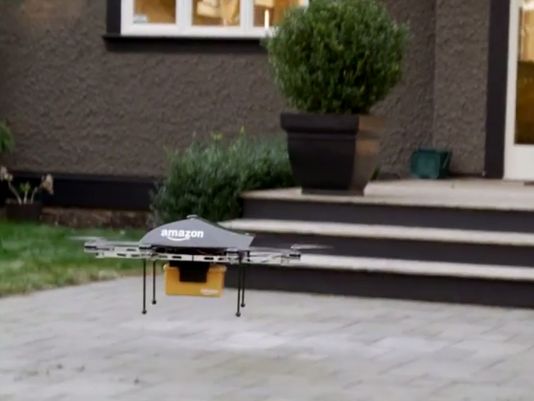By Doug Stephens

Analysts and consumers alike are becoming increasingly accustomed to Amazon’s announcements of bold and daring new projects. Most recently it was the Jeff Bezos’ 60 Minutes bombshell in which he announced his intentions of setting aloft a fleet of flying drones, dubbed Prime Air, to offer 30-minute or less delivery times in metropolitan markets.
Predictably, the media lit up with chatter about both the plausibility and impossibility of such a delivery method. Perhaps the most cogent argument against its likelihood was that in order to make any sense, a market – say… San Francisco – would require hundreds, if not thousands of these drones flying through its air space at any given time. This in itself would be largely unmanageable and unsafe and many doubt the FAA would ever approve such a thing – at least not in the foreseeable future.
On the other hand, the best argument in support of the idea was that it was none other than Jeff Bezos who was saying it would be so. Bezos seems to have trouble forming the words “can’t” or “impossible”, and as a result, Amazon often seems to achieve the unachievable. After all, many thought Bezos was mad to allow users to post both positive and negative reviews on books; something now regarded as best practice. Many thought it was ludicrous to ask customers to pay for superior service, yet Amazon Prime memberships are a thriving aspect of the business. Add to this the seemingly endless list of product categories – from groceries to cloud computing services – and Bezos’ vision and tenacity becomes abundantly obvious.
Time Is Amazon’s Real Competitor
What few would debate though, is the clear and present need for Amazon to continue to keep pushing the envelope with respect to delivery times and methods. It’s going to be essential if they are to stay well ahead of the market.
Some improvements can be made inside Amazon warehouses. Surprisingly, much of the picking and packing of orders remains a manual process. While there has been experimentation with robotics to perform some of these tasks, even with automation, it’s unlikely that time gains in order processing would yield the sort of exponential speed improvement needed to propel Amazon into an untouchable position on delivery times.
There is, however, a compromise
I feel that what is more likely is that Amazon will, at some point within the next five to ten years, deploy a fleet of electric, autonomous (driverless) vehicles. Already, companies like Google have been successfully testing driverless cars for several years and states like California are already creating formal regulations for their continued testing. Automakers such as Volvo are planning large-scale tests in as little as three years and BMW has a 2020 target date to have driverless cars widely available for commercial use.
While such vehicles may not offer the ‘as-the-crow-flies’ timesaving of drone copter delivery, a dedicated Amazon fleet would likely be faster than couriers and the vehicles being both electric and driverless, would offer significantly lower operating costs. Couple this with digital delivery lockers strategically placed throughout major markets and at customers’ homes packages could potentially be delivered in minutes, day or night.
Flying drones certainly capture the imagination and do seem truly fantastical. In my opinion however, the autonomous, electric vehicle fleet is a strategy far more grounded in reality – at least in the short term. But then again, no one ever accused Amazon of thinking short-term.

